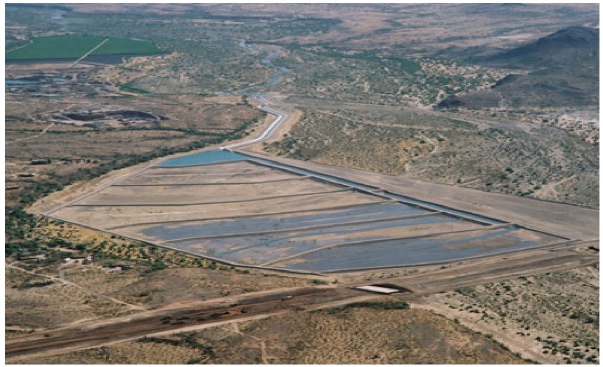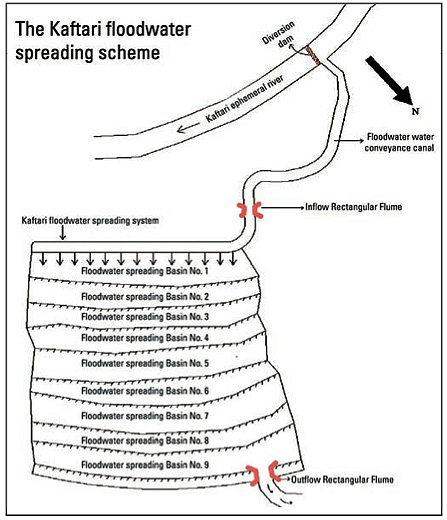Difference between revisions of "Water Portal / Rainwater Harvesting / Groundwater recharge / Controlled flooding and Spreading basins"
(Created page with "Groundwater recharge in spreading basins, Arizona. Source: CAP (2002) This is a floodwater harvesting technique where the...") |
|||
| Line 1: | Line 1: | ||
[[Image:ControlledFlooding.jpg|thumb|right|400px|Groundwater recharge in spreading basins, Arizona. Source: CAP (2002)]] | [[Image:ControlledFlooding.jpg|thumb|right|400px|Groundwater recharge in spreading basins, Arizona. Source: CAP (2002)]] | ||
| − | This is a floodwater harvesting technique where the water diverted from a river, with the help of diversion structures and canals, is spread evenly over a large surface area where it is used for recharging groundwater, irrigation, filling ponds, and watering grazing land. The concept is that a thin sheet of water flows over the land but at minimum velocity in order to avoid disturbing the soil cover. This includes [[Irrigation_-_Spate_irrigation|spate irrigation]], but also standard channel irrigation which takes river water via channels to fields (covered in the Surface Water section of Water Studio). | + | This is a floodwater harvesting technique where the water diverted from a river, with the help of diversion structures and canals, is spread evenly over a large surface area where it is used for recharging groundwater, irrigation, filling ponds, and watering grazing land. The concept is that a thin sheet of water flows over the land but at minimum velocity in order to avoid disturbing the soil cover. This includes [[Irrigation_-_Spate_irrigation|spate irrigation]], but also standard channel irrigation which takes river water via channels to fields (covered in the Surface Water section of Water Studio). This article will focus on controlled flooding / spreading basins for use in groundwater recharge. |
==Suitable conditions== | ==Suitable conditions== | ||
Revision as of 01:44, 5 April 2012
This is a floodwater harvesting technique where the water diverted from a river, with the help of diversion structures and canals, is spread evenly over a large surface area where it is used for recharging groundwater, irrigation, filling ponds, and watering grazing land. The concept is that a thin sheet of water flows over the land but at minimum velocity in order to avoid disturbing the soil cover. This includes spate irrigation, but also standard channel irrigation which takes river water via channels to fields (covered in the Surface Water section of Water Studio). This article will focus on controlled flooding / spreading basins for use in groundwater recharge.
Contents
Suitable conditions
Site in areas of high volume and intensity river flows where conventional irrigation structures are not feasible (spate systems should probably be promoted in areas where the practice is already in use).
| Advantages | Disadvantages/limitations |
|---|---|
| - Minimum land preparation is needed, so is very cost-effective compared to other infiltration methods - Most of the sediment load in the river water will settle on the land, e.g. 70% – this can be advantageous for agriculture |
- Large surfaces of land have to be made available for it to work - River flows in ephemeral rivers can be unpredictable in time and volume, which can lead to unpredictable spread on the land and damage to
structures |
Construction, operations, and maintenance
- It is better to concentrate efforts on low-cost diversion structures and to avoid sophisticated technological solutions. Efforts should be based on improving existing intakes.
- If using controlled flooding for irrigation, farmers should be more involved in development of improved spate systems – the new system should build on existing practices and land rights, not undermine them as has happened in the past.
Pre-construction considerations
Spate floods are variable and difficult to predict using conventional rainfall-runoff models because rainfall is often not correlated to runoff in ephemeral rivers that feed spate systems. Large scale permanent structures built to resist the hostile conditions of full river flow are economically unfeasible and also still prone to damage and siltation. Although siltation brings nutrients, it also creates one of the major difficulties with spate irrigation – sediment load tends to be between 3-10% in seasonal rivers with particle size varying from silt to boulders. Silt causes problems of silting up channels, raising farmland and causing river courses to change direction and miss the diversion structure altogether. There are also large quantities of floating debris which can cause problems for intakes.
The following are recommended:
- Rebuilding parts of the system after major floods can be a more cost-effective option than designing more permanent structures. Traditional diversion structures work well at a fraction of cost of other types and also work better – they can breach in high floods (heavy silt-laden water does not come out onto land).
- Improvements in water distribution and moisture conservation may be more beneficial than focusing only on improving diversion structure efficiency (see Bunds). Where this is not yet practised, it should be promoted.
- Physical changes to traditional systems should be made so as to be as flexible as possible, given the uncertain and highly variable nature of spate flows. Traditionally, spate irrigation has incorporated this flexibility with farmers moving to different areas when needed.
- Incremental structural reinforcements to existing traditional intakes have been proven as cost-effective and more successful than larger scale interventions.
- Simple diversion structures with no gate is made from gabions, rubble masonry or concrete. They are simpler for farmers to maintain using indigenous skills. Flow-restricting structures and rejection spillways need to be included at heads of canals to prevent large uncontrolled flows from damaging canals and irrigation infrastructure.
Operations and maintenance
Systems should be self-reliant with regards to routine operation and repair, but some backstopping from public sector units is a good idea:
- Spate systems rely on communal management and dialogue due to their scale. Projects should not attempt to unnecessarily formalize agreements for maintenance – farmers should be the drivers for this. However, any user associations should be based on catchments or communally-used areas.
- Provision of bulldozers has been very popular and has enabled spate farmers to build or restore damaged structures more easily. Problems with that is that sometimes downstream effects become too great since farmers upstream can build much larger structures, and also that bulldozers cannot easily be run and maintained in a self-sustaining fashion due to high costs. Support is therefore too large for small farmer groups and is best organized on a regional basis through local government, or with subsidies to allow participation of the private sector.
Costs
Field experiences
Iran
Overexploitation of groundwater has caused significant drawdown of the water table (1.5m/year) and deterioration of groundwater quality in the Dorz Sayban Plain, which is located 115 km to the southeast of Larestan, Iran. 3500 hectares of land are irrigated using groundwater in this plain. To decrease the rate of the drawdown of the water table, five floodwater spreading systems for recharge of groundwater were designed and constructed in the region 1983 and 2001.
Inflow and outflow rates from the Kaftari floodwater spreading system were measured for nine flooding events during 2002-2003 using rectangular flumes in the system. The maximum inflow and outflow rates in the system were 20.3 and 7.26 m3/s, respectively. The total volume of inflow and outflow of the system was about 886,000 and 146,000 m3 for the nine flooding events. Therefore, 83.5% of the inflow to the system was recharged to the aquifer, only small quantities being lost to evaporation. This shows the high performance of floodwater spreading systems in the recharge of groundwater.
More than 70% of the suspended load has settled in the system. This will inevitably lead to clogging and reduction in efficiency in the system, but also an improvement of the soil for agriculture purposes. Additionally, the managed aquifer recharge improves the quality of groundwater, as the EC of floodwater is much lower than that of the groundwater (0.3-0.4 versus 2.0-9.0 dS/m).
Reference manuals, operations and maintenance
- Sustainable Development of Groundwater Resources in Southern and Eastern Africa. International Atomic Energy Agency.
Acknowledgements
- CARE Nederland, Desk Study Resilient WASH systems in drought prone areas. October 2010.
- Gale, Ian, Strategies for Managed Aquifer Recharge (MAR) in semi-arid areas. UNESCO's International Hydrological Programme (IHP), 2005.


